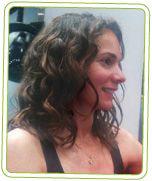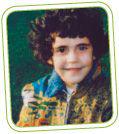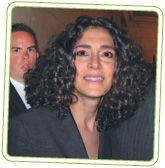B003YL4KS0 EBOK (19 page)
Authors: Lorraine Massey,Michele Bender

CURL CONFESSIONMichele Bender
coauthor,
Curly Girl
Though I’m a naturally curly girl, I was in total denial for six years. The first time I got my hair chemically straightened, the stylist asked, “Are you sure you’re ready for poker-straight strands?” Truth be told, I didn’t care if I looked like Marcia Brady. I couldn’t stand another day of frizz and as the mother of a one-year-old, I had no time to spend on my curls. Once he was done, I loved the results—finally, I had shiny, soft strands that blew in the wind and didn’t frizz.
Cut to six years later. It was time to get my hair straightened again, but I just couldn’t do it. First, I was tired of the flat, plastered-to-my-head look that chemically straightened hair often has. Second, I hated the feeling that the moment I stepped out of the salon, the curly hair time clock was ticking. And, third, I noticed some gray and knew that coloring and straightening was too much for my hair to handle. Most important, I was working with Lorraine on this book, and I had interviewed so many women who grew up hating their curls like I did but had learned to treat them right and now actually loved their hair. Too bad, that now that I knew how to make my curls look great, I didn’t have them anymore.
So I set out on a journey to go curly. I knew it wouldn’t be easy and that I’d have to spend at least a year or more with two textures of hair on my head. One time before an important work event, I couldn’t stand how the top three inches of curly hair looked against the bottom eight inches of straight. Like a drug addict needing a fix, I started scrolling frantically through my Blackberry for the number of the salon where I had my hair straightened and slipped into the next room to make an appointment (I later canceled it).
During most of that year, I religiously conditioned my hair in the shower, and then at night I’d slather more conditioner on my dry hair and sleep on a satin pillow, knowing my curls were coated in hydration. I became obsessed with noticing curly hair—on the subway, at coffee shops, at my kids’ school—and when gazing into the bathroom mirror. I started a blog on Naturallycurly.com, and was amazed at how much I had to say about my hair.
There were many months when my hair looked like a bowl of mixed pasta: The top looked like elbow macaroni; the bottom, angel hair pasta; and underneath, rotini. I was shocked that I wasn’t even tempted to blow-dry my hair. I figured that if I was going for the curl, I wanted to give those virgin hairs a fighting chance and let them be. Almost two years later, I finally have most of my curls back. And I promise to spend the rest of my life giving them the respect they deserve!

Curl knowledge and wisdom equals curl love forever!
If you’re like most curly girls, you’ve spent a lot of time and money searching for the product that is
the one
. You imagined that, like a knight in shining armor, it would rescue your curls from frizz, flyaways, and dryness. It’s this continual search for frizz-free locks and our severely misunderstood hair type that keeps the big beauty companies in big business. When I peruse the aisles of beauty supply stores, I’m amazed at the language used to describe products that claim to be made for us curlies, such as “taming,” “controlling,” “sealing,” and “flattening.”
These words are chosen to intimidate us and make us feel less than OK, again and again and again. Faced with all this jargon, what’s a curly girl to do? Don’t be fooled by the hype! Be an educated curly consumer. Know what you’re looking for in a product and learn how to read a label.
Ingredients at the beginning of the list are the highest amounts in the product; ingredients toward the end of the list are included in smaller amounts, and ones near the very end are in such small amounts as to be meaningless.
The array of shampoos, conditioners, and styling products that fill store shelves is dizzying and overwhelming. But it doesn’t have to be. What follows is a guide to finding the right products to keep your curls looking their best.
CURL CONFESSIONRobin Berger
attorneyAs a child, I could never find anyone who knew how to cut my thick, curly hair (or knew what to do with it). When I got older and tried to grow it long, my curls would grow out instead of down, so I looked like Bozo the Clown. I spent hundreds and hundreds of dollars on products and tried salons that claimed to specialize in curls, but they were terrible. One left my hair looking like an oil slick, and suggested that I apply a product that actually removed my nail polish every time I used it. I wondered, if it’s doing that to my polish, what’s it doing to my hair?
Then I finally found a salon where they knew how to cut my curls. My first haircut felt like the greatest thing that had ever happened to me. Afterward, my social life picked up like you wouldn’t believe. My hair never looks bad (even at its worst, it looks better than it did when I was growing up), and I’m constantly stopped on the street and asked about my hair. My only regret is that I didn’t realize I had this beautiful hair earlier in my life.
THE GOOD, THE BAD, AND THE BUBBLY
CleansersLook for
Conditioners
sulfate-free
products only. Detergents frequently found in shampoo are sulfates such as sodium lauryl sulfate (the harshest), ammonium laureth sulfate (also harsh), and sodium laureth sulfate (harsh). Always check the ingredients list on the product to make sure none of these detergents are included.Look for a
botanical conditioner.
Botanicals should contain high concentrations of plant-based ingredients such as mint, lemongrass, and rosemary. They will help maintain a photoprotective shield around hair shafts. And many botanicals offer specific benefits to curly hair, like adding moisture. Make sure that the plants used in the product are listed in the first half of the ingredients list; otherwise the amount is too negligible to be helpful to your hair.Look for a conditioner that contains:
•
Emollients
soften hair and reduce frizz by smoothing the cuticle. There are hundreds of emollients, but some good ones for curly hair include shea butter, vegetable oils, olive oil, walnut oil, jojoba oil, cetyl esters, and wheat germ.•
Humectants
absorb water from the atmosphere and hang on to it. They’re absolutely crucial in a conditioner for curly hair. Some to look for include panthenol, vegetable glycerin, and sorbitol.•
Moisturizers
add softness and control to curly hair. Look for amino acids, aloe vera, olive oil, balm mint extracts, and propylene glycol.Steer clear of products that contain:
•
Gels
Silicone.
This synthetic material is the active ingredient in many conditioners and 99 percent of shine products. Often used in manufacturing rubber, plastics, and polishes, it’s actually made to repel water and isn’t biodegradable. So any product with silicone in it will act as a seal around the cuticle, preventing the absorption of moisture. Silicone can also weigh down your curls, preventing their natural shape from emerging.When shopping for gel, do the skin test. Apply a little bit to your hands and rub them together. If it feels sticky on your skin, it will probably feel sticky on your hair. Also avoid products that say they are “styling creams” or “waxes.” These make hair crispy, like Ramen noodles (not a good look!).
Also, steer clear of gel that contains:
•
Alcohol.
Curls should be seen and not heard, and alcohols in gels can cause hair sound effects. The right gel will leave your hair frizz-free and touchable, and all you’ll hear is how curlicious you look! Certain alcohols, like cetyl alcohol, are okay if they’re in a cleanser, but those used in gels can be extremely drying for hair and cause frizz. Plus, unlike cleansers, which get rinsed out quickly, gel lives in a curly girl’s locks for a day or more. If the gel contains alcohol, it will spend those days sucking up your strands’ moisture and will prevent new hydration from getting in.•
Silicone.
You don’t want silicone in your gel for the same reasons you don’t want it in your conditioner. It repels water, preventing the hair from absorbing the moisture it needs. And a gel is on the hair longer than any other product.•
Parabens.
One of the most widely used preservatives added to cosmetics (as well as foods and drugs) to ward off the growth of bacteria. Those you’ll typically find in an ingredients list include methylparaben, propylparaben, and butylparaben. In recent years, they’ve become controversial as experts question whether they are safe. (Some say they may be linked to cancer.)•
Phthalates.
Used in plastics for longevity; many are being phased out because of health concerns.
MAKE A SPRAY GELSpray styling gels are basically diluted versions of gels. They’re especially good on loose, wavy curls because the mist gets lightly distributed through the hair without weighing it down. They’re also a wonderful way to refresh all hair types during the day. You can buy one or make your own spray gel by combining ½ cup gel with 1 cup boiled water. Allow the mixture to cool, then pour it into a spray bottle. If you think your hair needs a stronger hold, experiment by gradually adding more gel to the mixture until you achieve the consistency that works best for your curls.



